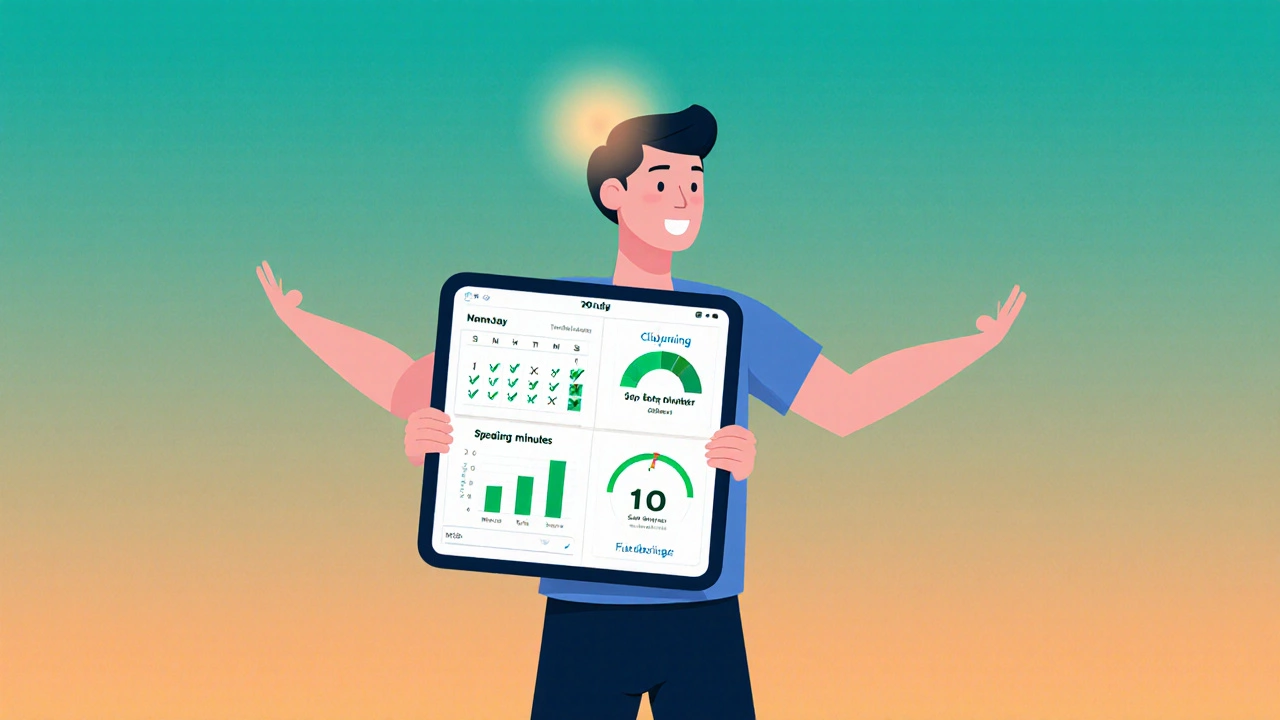Confidence Progress Tracker
Daily Confidence Log
Progress Overview
Current Confidence Level
Based on your last 7 days of practice
Weekly Progress
65% of your weekly goal completed
Your 30-Day Confidence Plan
Daily average: 7.8 minutes
+2.1 since start of week
+3 since last week
Ever felt your voice wobble the moment you try to speak English in front of others? You’re not alone-confidence is the missing link that turns a hesitant learner into a fluent communicator.
What is English speaking confidence?
English speaking confidence is the belief that you can express ideas clearly and be understood, even when you make mistakes. It isn’t about perfect grammar; it’s about showing up, speaking, and learning from the experience.
Why confidence matters more than grammar perfection
- People judge fluency by flow, not flawless sentences.
- When you’re confident, your brain releases dopamine, which improves memory recall.
- Confidence reduces anxiety, letting you focus on meaning instead of fear.
Three proven habits that instantly raise confidence
- Daily shadowing - repeat a native‑speaker audio word‑for‑word, matching rhythm and intonation.
- Language exchange - partner with a native speaker who wants to learn your language.
- Public‑speaking clubs - join groups like Toastmasters to practice in a low‑stakes setting.
Habit #1: The Shadowing technique
Shadowing is an active listening‑repeat exercise that trains pronunciation, rhythm, and speech patterns. Grab a 2‑minute podcast, press play, and speak along, trying to match every pause and stress.
- Start with short clips (news headlines, movie trailers).
- Record yourself after each session; notice where you lag.
- Gradually increase clip length to 5‑10 minutes.
Habit #2: Language exchange
Language exchange pairs a learner with a native speaker who wants to learn your language. It creates a win‑win: you practice speaking, and they practice listening.
- Use platforms like Tandem, HelloTalk, or local university language clubs.
- Set clear goals: 15 minutes of speaking, 5 minutes of feedback.
- Rotate partners every month to expose yourself to different accents.

Habit #3: Public‑speaking clubs (Toastmasters)
Toastmasters International offers structured speaking sessions where members deliver short talks and receive constructive feedback. The supportive environment removes the fear of judgment.
- Find a local chapter in Auckland or join a virtual meeting.
- Start with the “Ice‑Breaker” speech-just 4‑5 minutes about yourself.
- Apply the “Evaluation” feedback to each subsequent talk.
Supporting tools that amplify confidence
- Self‑recording apps
- Pronunciation drills (e.g., Elsa, Speechling)
- Mindset techniques (growth mindset, visualization)
- Body language cues (open posture, eye contact)
Comparison of three confidence‑building methods
| Method | Typical Time Commitment | Primary Skill Focus | Social Interaction | Cost (USD) |
|---|---|---|---|---|
| Shadowing | 10‑20 min daily | Pronunciation & rhythm | None (solo) | Free‑to‑low (audio source) |
| Language Exchange | 30‑60 min 2‑3× week | Conversational flow | One‑on‑one | Free (app) or minimal platform fee |
| Toastmasters | 1‑2 hrs weekly | Public‑speaking structure | Group (6‑12 members) | ~$45 annual dues |
Step‑by‑step confidence‑boost plan (30‑day sprint)
- Week 1 - Install a shadowing app, pick a 2‑minute news clip, and shadow for 10 minutes each day.
- Week 2 - Add a 15‑minute language‑exchange session twice a week. Record the conversation and note three new phrases.
- Week 3 - Attend your first Toastmasters meeting (or watch a recorded demo if you can’t travel). Deliver a 3‑minute “Ice‑Breaker.”
- Week 4 - Combine all three: 5 minutes shadowing, 20 minutes exchange, and a 5‑minute club speech. Review recordings, celebrate progress, and set the next month’s goal.

Common pitfalls and how to dodge them
- Fixating on perfection. Accept that mistakes are data for improvement.
- Inconsistent practice. Even a 5‑minute daily habit beats 30 minutes once a month.
- Choosing the wrong partner. Pick exchange partners who correct kindly and focus on communication.
- Neglecting feedback. Use the “sandwich” method: start with a strength, give a specific tweak, end with encouragement.
Measuring your confidence gains
Track three simple metrics every week:
- Speaking minutes. Total time you spoke English out loud (including shadowing, calls, clubs).
- Self‑rating. Rate your comfort on a 1‑10 scale after each session.
- Feedback count. Number of constructive comments you received and acted on.
When you see a steady upward trend, your confidence is solidifying.
Quick cheat‑sheet for instant confidence boost
- Start every conversation with a simple ice‑breaker (e.g., “How’s your day?”).
- Use a “pause‑and‑repeat” - think before you speak, then repeat key points.
- Adopt open body language: shoulders back, chin slightly down, maintain eye contact.
- Take a 30‑second deep‑breath before any speaking situation.
Next steps after you finish the 30‑day sprint
Celebrate the habit formation, then level up:
- Expand shadowing to longer podcasts or TED Talks.
- Lead a mini‑workshop for your language‑exchange group.
- Take on a Toastmasters “Competent Communicator” project series.
Each new challenge reinforces confidence like a muscle‑building routine.
How often should I practice shadowing?
Aim for 10‑20 minutes daily. Consistency beats occasional marathon sessions because it trains your brain to think in English.
Can I improve confidence without a conversation partner?
Yes. Solo techniques like shadowing, self‑recording, and speaking to a mirror build fluency. Pair them with occasional feedback from a tutor or app.
What if I feel nervous in a Toastmasters meeting?
Remember the club’s purpose is supportive practice. Arrive early, introduce yourself to a friendly member, and use the “pause‑and‑repeat” trick before you start.
How can I measure real progress beyond feeling confident?
Log speaking minutes, self‑rate after each session, and track the number of corrective feedback points you act on. A steady rise in these numbers signals genuine improvement.
Is there a cheap way to join a public‑speaking club?
Many clubs offer a free trial meeting or virtual sessions at no cost. Check the Toastmasters International website for nearby chapters that allow guests.





